Archive for July, 2016
Friday, July 15th, 2016
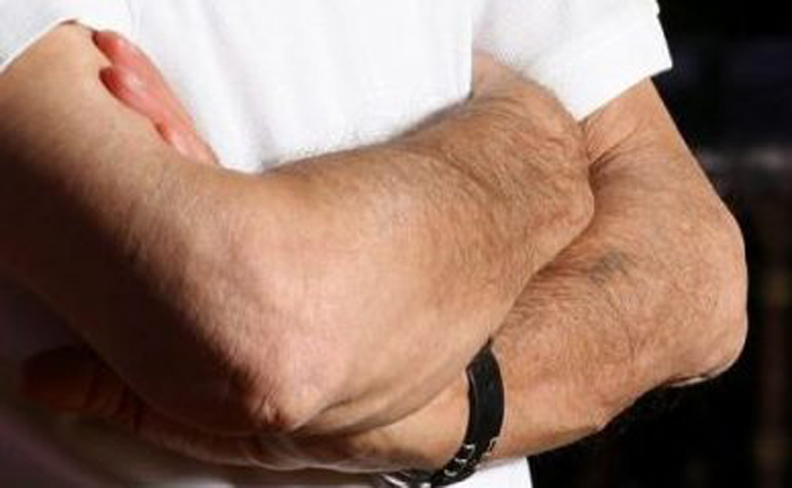
Enlarged close-up of Elie Wiesel’s arms in a 2006 photograph by Eyal Toueg, first published in Haaretz (see previous article).
by Carolyn Yeager
copyright 2016 Carolyn Yeager
It’s pretty pathetic to be confronted with a picture like the above, and expected to acknowledge that it is Elie Wiesel’s Auschwitz tattoo that I have been asking to see for six years now. Once again, the best suggestion I have for magnifying it is to click on it to get the image page, then hit the plus key up to 8 times while holding down the Ctrl key. The image stays sharp while being greatly enlarged. What do you see? I invite all the amateur, and maybe professional sleuths out there to do their thing.
Wiesel has been hiding this faded-out, so-far-undecipherable spot on his arm for 70 years, and now that he’s safely buried and completely inaccessible, Haaretz, the Israeli newspaper that broke the story of Wiesel’s death, is beginning to reveal that arm. At least, that’s how it looks from where I’m sitting.
To the naked eye, it appears to be a bruise on the arm. Upon magnification, we can barely make out what appear to be numbers, but it’s not at all clear what numbers they are. I think I see a couple but I’m not going to reveal what they are because I want a better image – and think we all deserve one. The dark and light lines made by his arm hair create a confused mess, visually. What we need are more high-resolution photographs like this one, preferably with a straight-on view of the arm. The photographer Eyal Toueg must have taken many shots on this day in 2006 and he would have all the negatives. It is his responsibility to publish them all, every one that shows Wiesel’s left arm, but he is probably Israeli and is under the dictate of higher ups. Someone else may have bought all the negatives. Maybe Haaretz owns them.
As it is, we are left with many questions – such as, why has Wiesel refused to show his supposed faded tattoo over the years? Is it because it’s unreadable? If he revealed it, the public would question it – or at least sceptics would – and he was not prepared to answer questions. Probably, if there were journalists who took a genuine unflinching investigative approach, he would have been forced to discuss it, but none did. The efforts of Jean Robin of Enquete & Debat website to encourage such an investigation show conclusively that lack of journalistic willingness.
Has it been kept hidden because it is not A-7713? Could that be why whatever was there has been defaced or somehow unnaturally/synthetically faded or smeared? I cannot find any example of an Auschwitz tattoo that looks like his does.
Is it because it is something he put on his arm himself when he was a youth in France? In this 1945 b&w photograph (below) taken at the French orphanage for Jewish boys we see what looks like an Auschwitz tattoo, albeit a tiny one, on Wiesel’s arm in the same place we see the dark spot in the 2006 photo.
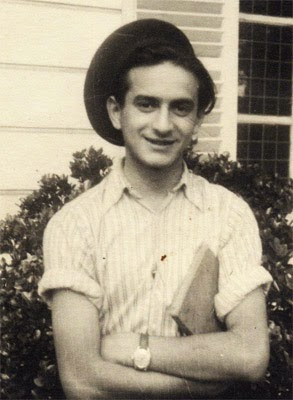
Elie Wiesel in summer 1945 in France – 16 going on 17 years of age.
The ready conclusion is that it’s his Auschwitz tattoo A-7713. But we can’t make it out at all! It’s already faint in 1945 and when I magnify it, no part of it is recognizable.
It’s also interesting that this photograph was posted on the Internet by French Jew Loupi Smith, but it doesn’t seem to be in the US Holocaust Memorial Museum online collection (where it is hopeless to try to view their Wiesel photo collection, anyway; they obviously don’t want you to see it). Nor is it in the Yad Vashem photo collection under Elie Wiesel – in fact, they have only 3 photographs with Wiesel in them – all the rest are aerial views of Auschwitz-Birkenau! Really weird. I think this decision to withhold pictures of Wiesel can only have come from Wiesel himself. In my opinion, though, the above is definitely a photo of Elie Wiesel in 1945 in France.
Our next pictures are these two, which show the same mark on the arm in the same place, but both are still completely unreadable as numbers. I assume these pics are from the same 2006 photo shoot that produced our newest picture, which is a much better high-resolution image. We can see sharp detail, but the “tattoo” is still not decipherable. It’s a really bad “tattoo!” The problem does seem to be with the “tattoo,” not the photograph. It is just very faint.
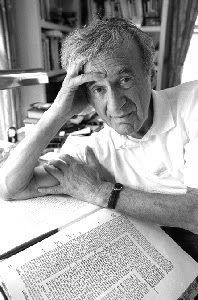
When this 2006 image is magnified, the possible “tattoo” is seen only as a darker spot, not recognizable as a number.
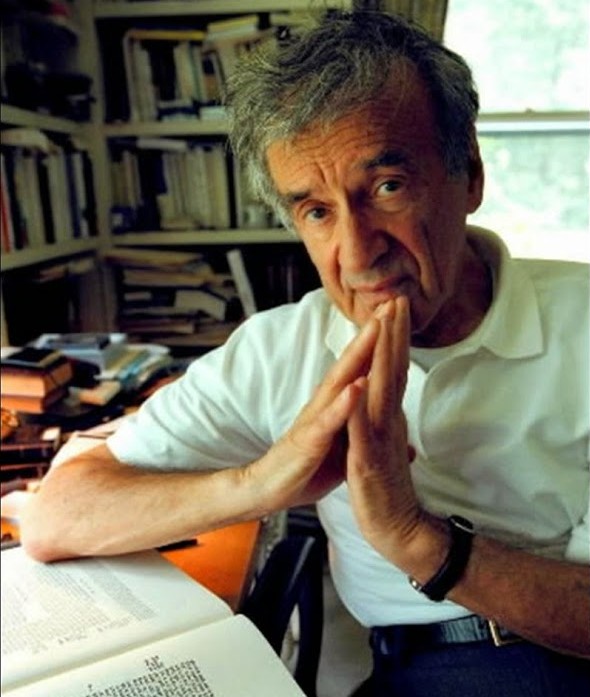
This image was also uploaded by Loupi Smith, but where did he get it? It’s obviously from the same 2006 photo shoot by Eyal Toueg.
Now take a look at another man’s equally hairy arm below– he is Erwin Farkas who was transported to Auschwitz from Hungary in 1944 at the age of 14. His number, A-7899, is only 186 digits beyond A-7713 – they are in the same time frame. His tattoo is faded and a little blurred, but still legible. There is no discoloration of the surrounding skin and the numbers are definitely blue. In fact, all the tattoos that one sees on the Internet are in this good of shape or better (many are fake though).
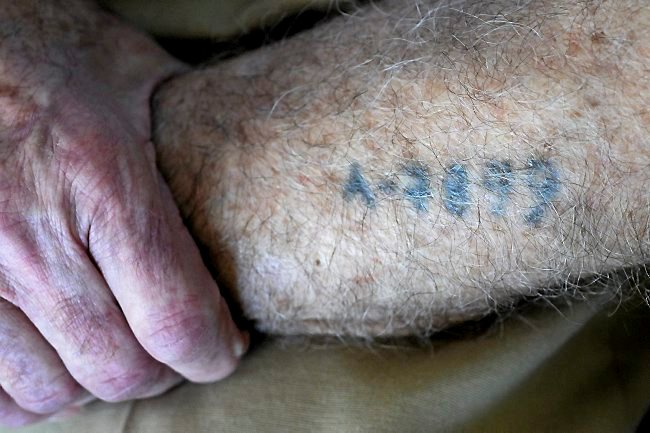
Erwin Farkas displays the Auschwitz tattoo A-7899 on his arm.
What happened to Wiesel’s that it is almost impossible to see? Only Wiesel could answer that – or would – so it’s clear that he didn’t want to since he didn’t allow the higher quality picture at the top of this page be published during his lifetime.
In the “court of public opinion” and morally (if not legally), there is no excuse for Elie Wiesel to have been given the velvet-glove treatment he was by journalists and by historians. He had a duty to show the tattoo he said was on his arm and allow it to be photographed. He had a moral duty to prove that it was what he said it was—A-7713. His failure to do that over the course of many years makes him, and the mainstream media that enabled him, guilty of worse than negligence — they are guilty of withholding evidence. The media and academics are more guilty than Wiesel himself because Wiesel has to be given the right not to incriminate himself.
But morally, Wiesel is guilty of withholding evidence that was available all the time.
Above, I used the words “higher quality” but if all these pictures of Wiesel in the white knit short-sleeve shirt were taken on the same day by a professional photographer (which it makes sense that they were) then they should all be of similar high quality. And since we can’t make out the numbers on any of the three, it can only be that it’s the fault of the ‘tattoo,’ not the photography.
I don’t believe this latest-to-be-revealed photograph from 2006 is photo-shop in any way. I do believe this is what Wiesel has on his arm, which he always claimed was A-7713. If it turned out to be A-7713, I would’t be upset in the least because all I’ve ever wanted was the truth about Elie Wiesel. But there will be questions and I will have a very hard time reconciling myself to the idea that the SS camp authorities could have made up a registration card for a 15 year old boy with the information that he was a 31-year-old man with the occupation of Schlosserlehring (Locksmith) – and never correcting it – allowing this boy to enter Buchenwald with that identification. No, it would be very hard to believe that.
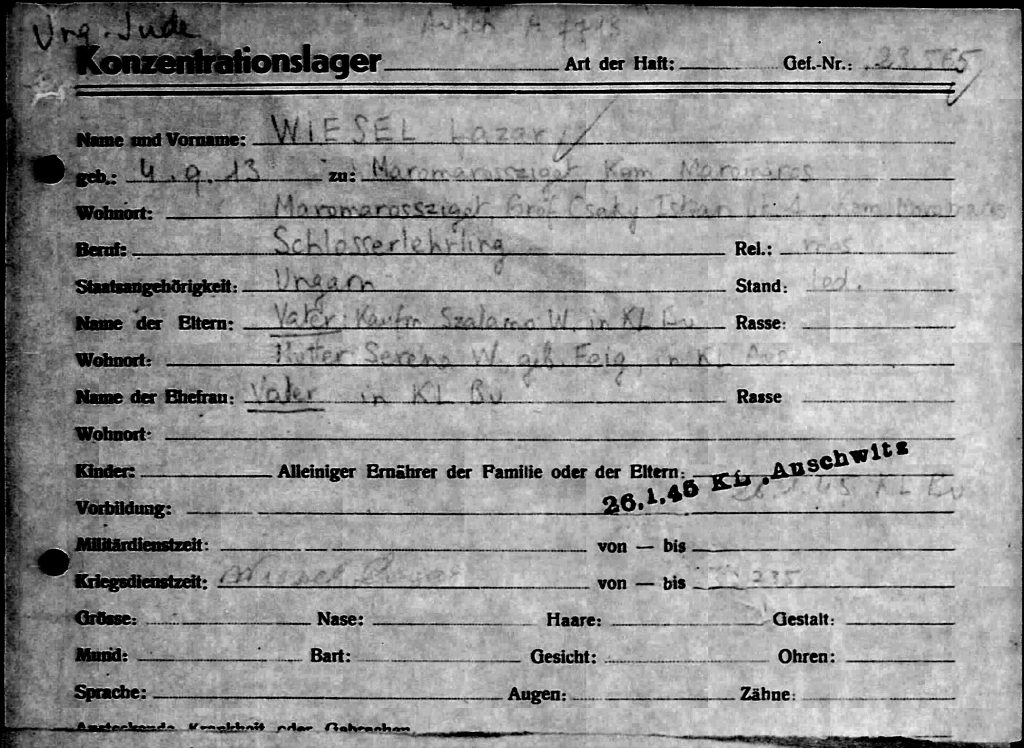
The Buchenwald file card that shows Lazar Wiesel, born Sept. 4, 1913 (age 32), occupation locksmith, A-B prisoner number A-7713, arrived in a transport that left Auschwitz on Jan. 26, 1945.
So I can only hope that more of these photos by Eyal Toueg will be published. Because as it stands now, Elie Wiesel’s tattoo claims still don’t pass the most elementary test – that of what the heck is the number!
12 Comments
Category Featured | Tags: Tags: Auschwitz tattoos, Elie Wiesel, Erwin Farkas, Lazar Wiesel,
Social Networks: Facebook, Twitter, Google Bookmarks, del.icio.us, StumbleUpon, Digg, Reddit, Posterous.
Saturday, July 9th, 2016
BY CAROLYN YEAGER
copyright Carolyn Yeager 2016
Though they say a picture is worth a thousand words, these two need some explanation. One is from 1987, the other from 2006. Since the more recent one will arouse much more attention, I better start with that.
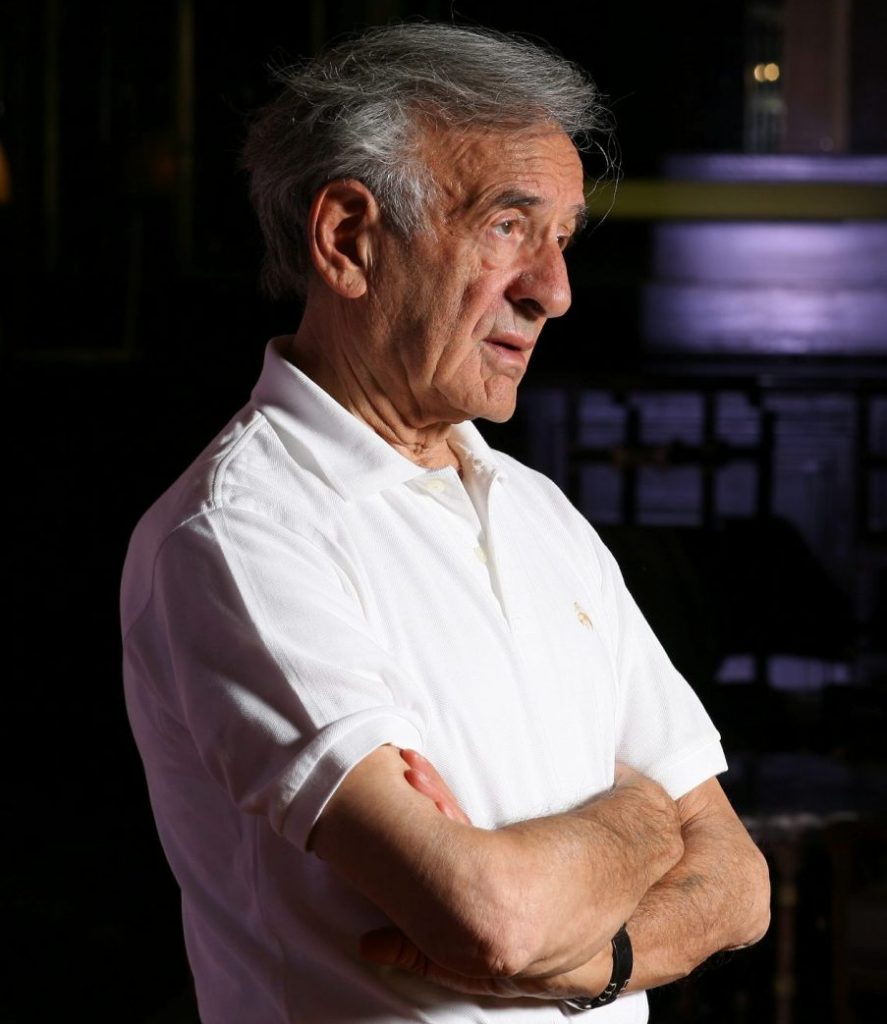
This 2006 photograph taken by Eyal Toueg, displayed in a July 9th “Premium” article by Shlomo Nakdimon at Haaretz, has been cropped by me to remove some of the dark space to the right … the better to see the important details. This may be the first time it has been published.
You will notice right away that there is a smudge on Wiesel’s left forearm, precisely where an Auschwitz tattoo would be. Many people will say, Oh, that’s his very, very faded and blurred tattoo. But it looks more like a bruise, and, by using your keyboard to enlarge the image while retaining a clear resolution, you’ll find, as I did, that it then looks even more like a bruise the larger you go. Plus there seems to be more bruise just above it where his right arm meets his left. [I’m speaking tongue-in-cheek here, and below. I don’t actually think it is a bruise, but all we can see, even highly enlarged, is a smudged blue area that looks like a bruise. So what are we to call it?]
[To enlarge the image, first click on it to get the full size image, then hold down the Ctrl key while clicking the plus (+) key as many times as you can or want. To bring it back to normal, do the same with the minus (-) key. Both keys are on the upper right next to “backspace”]
This photograph has to be from the same photo session that includes the one where he’s sitting with the oversize Hebrew book — he’s wearing the same white knit golf shirt and his hair is the same. That one has been used by Wiesel defenders to suggest there is a faint tattoo on his arm. You can see it here and here.
However, this kind of thing is the typical Wiesel mode of operation throughout his life. He refuses to be explicit about his person and his personal life, even though he gets very explicit about things like the “shades of wateriness of the soup” and the face of the boy he wrote was hanged in Auschwitz. But his own body–which can be checked–he offers not a word of description. And looking at this blue-black discoloration, I can see nothing—even with using all my imagination—that I could imagine to be a 7713. I know you can’t either, but you might try to come up with some theory about it. I have my own theory, that Wiesel pinched himself real hard the day before the photographer came.
In 2006 he was 77 years old, an age when it’s extremely easy to bruise the skin. And that’s what it looks like. Recall the tattoos of so many other inmates from his same time there — none look like this.
But I have a second theory, which might be better — that Wiesel had applied his own tattoo number with ink but he didn’t go deep enough. It was only applied to the dermis (outer layer of skin), not the epidermis, and so it disappeared over time as new skin cells grew until now it is just a smudge of dispersed ink. Remember the top photo on this page that doesn’t look like a real tattoo — this may be when he did it.
Now, the other picture indicts him even more. He is in Lyon, France for the Klaus Barbie show trial and stops by the Holocaust Memorial there on June 2, 1987. He just won the Nobel Peace Prize 6 months earlier, and this Buchenwald liberation photo was associated with him winning that prize. You recall right after the ceremony he traveled to Yad Vashem in Jerusalem and posed in front of a large blow-up of this very photograph.
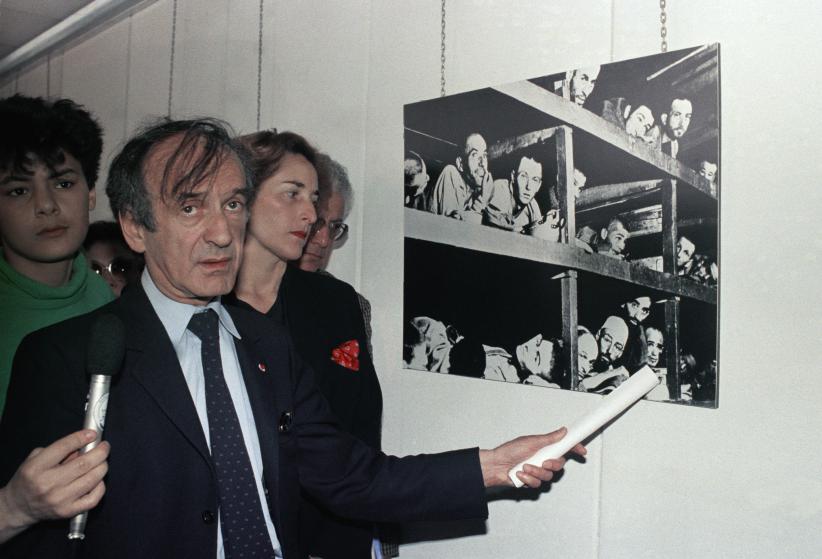
Elie Wiesel, winner of the 1986 Nobel Peace prize, visits the Holocaust Memorial in Lyon, France, June 2, 1987. The photo on the wall shows prisoners of the German Buchenwald concentration camp inside their barracks, five days after U.S troops took over the camp near Weimar, Germany. Wiesel points to himself in the picture. (AP Photo/Laurent Rebours)
Notice that Michael Grüner on the bottom row was cropped out of this version, along with the tall standing man, but there is Mel Mermelstein peeking out from the upper far right. Mel wrote a whole book about his incarceration before Wiesel said in 1983 that he was in this picture, but Mel never mentioned knowing the already famous Elie Wiesel there in his book! Mermelstein resided in the children’s barrack, too.
In this photograph, the unkempt Wiesel is sealing his doom by pointing directly to the unknown person (not him) he is claiming to be himself. And with such a guilty expression, too! Nothing could prove his dishonesty and forgery better than this.
I came upon this picture in the Time magazine Elie Wiesel photo collection posted at the time of his death. When I saw this one I quickly saved it. This might be my all-time favorite picture of the Wiesel. I will surely make more use of it.
23 Comments
Category Featured | Tags: Tags: Auschwitz tattoos, Elie Wiesel, famous Buchenwald photo,
Social Networks: Facebook, Twitter, Google Bookmarks, del.icio.us, StumbleUpon, Digg, Reddit, Posterous.
Thursday, July 7th, 2016
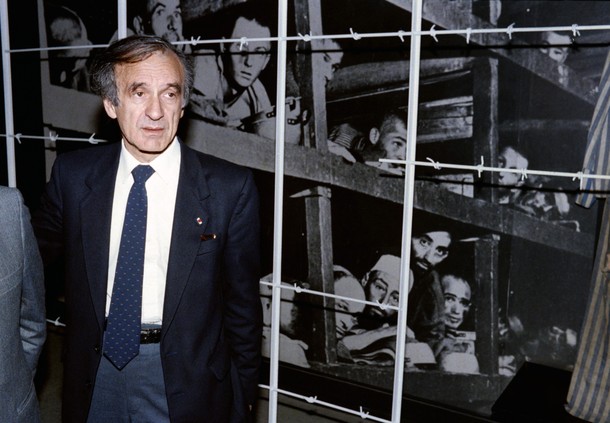
1986 Nobel Peace prize winner and writer Elie Wiesel (L) stands in front of a photo he claimed to be himself (bottom right hand corner) with other inmates, taken at the Buchenwald concentration camp in 1945, during his post-Nobel visit on December 18, 1986 to the Holocaust Memorial Center “Yad Vashem” in Jerusalem. SVEN NACKSTRAND/AFP/Getty Images)
BY CAROLYN YEAGER
The French website Enquete & Debat (E&D) has been on to Elie Wiesel’s failure to answer questions about his “missing” tattoo since 2012. The Jewish or part-Jewish chief of E&D is Jean Robin, and he is the one who has taken it upon himself, the past four years, to investigate what he calls the Elie Wiesel Affair. Robin has explained his position in this way: “I am also interested in these matters since a part of my jewish family on my mothers side died in Auschwitz, and a great grand father on my father side, Noël Robin, was deported to Buchenwald and died in Dora for resisting the nazis.” [For being active in the French Resistance, he means, just like Paul Rassinier who later turned into a revisionist. -cy]
Elie Wiesel Cons The World premiered on July 13, 2010. Enquete & Debat was established on June 18, 2010, but did not turn its attention to Elie Wiesel until Dec. 24, 2012, two and one-half years later. The first article based it’s information on Nicholas Grüner’s book Stolen Identity, Robin said. He wrote in that first article that they learned about Grüner from the American ‘Brother Nathanael’ (via Alain Sorel, the French négationniste), but Nathanael got most of his information from Elie Wiesel Cons The World. E&D has used an image that was created especially for EWCTW, so I know he is a follower of this site. Robin is careful not to give attention to it, though; he called me an “authentic nazi.”
M. Robin has done a beneficial service, which is much appreciated, by writing and phoning archivists at the Auschwitz-Birkenau state Museum in Oświęcim, Poland and the Elie Wiesel Foundation for Humanity in Romania, seeking information about Wiesel’s missing tattoo. The head person at the latter premises hung up on him when she learned the object of his call. He has made all of this public.
Unlike me, Jean Robin appears to be truly heartbroken over what he has discovered. He believes in the six million! He has written that he and Nicholas Grüner have repeatedly contacted news media and important figures within the Holocaust establishment with their information, imploring them to publicly question Wiesel, but got only insults or wishy-washy excuses in return. He believes that Wiesel’s forgery damages the Shoah story, and cannot understand why Wiesel is more important to these people than the entire Shoah. I don’t think he suspects, as I believe, that many of them already know the entire ‘Holocaust’ is a lie, but keep it up for the political power it gives them, or fear of that power. In his statement on Wiesel’s death (below), you can notice a tinge of bitterness mixed with the disappointment.
Elie Wiesel died before he confessed his lies about the Holocaust
Elie Wiesel, who lied about his identity, his Auschwitz tattoo that he does not have, and his imaginary detention in Buchenwald, as we have shown, has died. All media will praise a forger of history, whose lies have allowed deniers to create doubt about the Holocaust itself.
On this occasion, we have linked to all the articles we devoted to this infamous character [nine in all -cy], who is an enemy of the Jewish people and of Israel by his lies, his glory totally undeserved.
In my first article of 24 December 2012 [English version here], I wrote: “I am calling on the Jewish community throughout the world, personalities who are concerned about the Holocaust and the future of its memory, as well as major media to take responsibility and compel [Elie Wiesel] to answer the serious questions raised about him. This must be done while MM. Wiesel and Grüner, the two persons mainly concerned in this case, are by chance still alive, but unfortunately won’t be much longer because of their age (they are both over 80 years).” Alas, it is now too late, nobody took responsibility for Mr. Wiesel.
Jean Robin
M. Robin understands, because he uses logic and reasoning, not emotion and fear, that there is no redeeming the Shoah witness Elie Wiesel now. He has died a liar. As the icon’s friends pass away too, will there be anyone to defend him? The United States Holocaust Museum in Washington D.C. must be very undecided as to how to handle their founding chairman from here on. There is no doubt he did not have the tattoo on his arm – never had it. There is also no doubt that the “important Holocaust figures”–what I’ve been calling the Holocaust Lobby–were unwilling to allow the question to be asked. Indeed, and in fact, they joined in the lying (such as claiming Wiesel to be in the famous Buchenwald liberation photo) to help him get a Nobel Peace Prize. The top media liar would be the New York Times, followed by the Associated Press (AP), NBC and PBS, but all the rest went along too. While M. Robin will not consider the Holocaust-Shoah to be a hoax, he knows that “l’affaire Wiesel” is a hoax and that puts everyone who went along with it into question, whether he wants that or not.
12 Comments
Category Featured | Tags: Tags: Auschwitz tattoos, Elie Wiesel Cons The World, Enquete & Debat, Jean Robin, New York Times, Nicholas Gruner, USHMM,
Social Networks: Facebook, Twitter, Google Bookmarks, del.icio.us, StumbleUpon, Digg, Reddit, Posterous.
Tuesday, July 5th, 2016
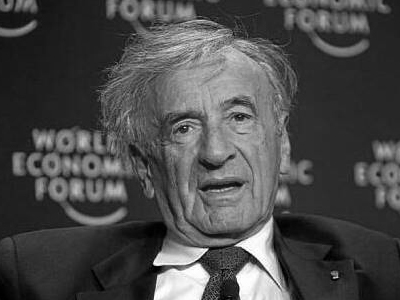
By David Blomstrom
July 2, 2016 marked the death of Elie Wiesel, who was probably second only to Anne Frank as the name most associated with the Holocaust. The timing was a little eerie, because I was hard at work on my series Jews 101 when I learned of Wiesel’s passing. It gets weirder still because another famous Holocaust survivor is currently making headlines — the famous Nazi-hunter, Simon Wiesenthal.
Wiesenthal died several years ago, but the city of New York recently cut off its “spigot of funds” to the Simon Wiesenthal Center, which is at the center of some huge scandal, like most Jewish “charities.” Speaking of corruption, did you know about Elie Wiesel’s connections to Bernie Madoff, who could be called the Elie Wiesel of fraud?
It all started with one of Elie Wiesel’s scams, the Elie Wiesel Foundation for Humanity, which he established in 1988. Like a number of other well-known Jewish “charities,” the Foundation was easy pickings for Uncle Bernie, the financier who was arrested in late 2008 and accused of running a $50 billion Ponzi scheme. Wiesel said he ended up losing $15.2 million in foundation funds, along with his and his wife’s own personal investments. He probably hated Bernie Madoff more than anyone except Adolf Hitler. The irony is that Hitler would have taken care of Madoff if he was still alive.
You see, Wiesel, Wiesenthal and Madoff are all Jews, and Madoff isn’t necessarily the worst of the three. Wiesel and Wiesenthal are both widely regarded as liars, and that’s just the beginning.
Wiesel and Wiesenthal both claimed to have spent time in Nazi concentration camps, and both milked their misadventures for all they were worth. Ironically, some people suspect that neither one ever set foot in a concentration camp. Indeed, Wiesel is perhaps the most popular poster boy for the Holohoax camp. Others believe there was a Holocaust of sorts and Wiesel and Wiesenthal really were caught up in it, but they greatly exaggerated the horrors they witnessed.
As I researched Elie Wiesel, I discovered a story so remarkable I’m amazed Hollywood never turned Wiesel into a movie star. The story is complex, too; Wiesel was a man who could be loved or hated, depending on one’s perspective.
So I decided to write two eulogies for Wiesel. The first is written from the perspective of an anti-Zionist or an anti-Jewarchist who hates Jewish corruption in general. The anti-Jewish/NeoNazi crowd will enjoy it, too. The second is written for the Elie Wiesel fan club, which includes people involved with the Holocaust Industry as well as Microsoft shareholders and the Andy Warhol cult.
1. The Bill Gates of Holohoaxers
Just for argument’s sake, suppose Wiesel wrote and spoke the truth, and the Germans who gave us the Holocaust were just as evil as he claimed. Suppose they were as twisted as Obama, who flaunts his Nobel Peace Prize even as he slaughters innocent people with unmanned drones and continues callously torturing people. I would still despise Elie Wiesel (who was also awarded the Nobel Peace Prize in 1986). Why?
[…]
Elie Gates, meet Bill Wiesel
However, a better comparison would be Elie Wiesel and Bill Gates. Combine Woody Allen’s forlorn face with Bill Gates’ famously untamed hair, and you might have an Elie Wiesel lookalike. But beauty is more than skin deep.
Like Bill Gates, Elie Wiesel was a con man. Like Gates he claimed to care about humanity while really advancing his personal agenda. Wiesel even attended the World Economic Forum in Switzerland, an event perhaps most closely associated with Bill Gates.
Oprah Winfrey, too!
Another person I’d like to weave into this story, just for the Hell of it, is Oprah Winfrey. Like Wiesel, she’s a media whore, though the similarities pretty much end there.
Oprah once declared that anyone who criticizes Obama must be racist, just as people who criticize Israel are racist. Obama, who has all but transformed into a Jew himself, showed his appreciation by giving Oprah the Presidential Medal of Freedom. Next thing you know, Oprah will follow Obama’s lead and start wearing one of those stupid Jewish prayer caps.
On second thought, Oprah does resemble Elie Wiesel in another important respect; she exploits child abuse the way the Weasel exploits the Holocaust. Which isn’t to say Oprah wasn’t really a victim of child abuse. Who knows?
Oprah once accompanied Wiesel to Germany, where they toured the concentration camps Wiesel once called home. Maybe some day she’ll visit Gaza.
The Arm Mystery
Elie Wiesel may have a secret in common with former Seattle Mayor Norm Rice. Rice was allegedly shot by his wife after she caught him in bed with another lover (a man). I always wondered why Rice didn’t shut critics up by just rolling up his sleeve and showing them a scar-less arm.
Similarly, Wiesel claimed the Nazis tattooed A-7713 on his left arm, but some critics claim he lied. The world’s most famous tattoo can’t even be seen in photos of Elie wearing short-sleeved shirts.
The Two Faces of Elie Wiesel
Wiesel did his part to prevent Iran from making nuclear weapons, though he apparently had nothing to say about Israel’s illegal nuclear arsenal. The Times (London) refused to run his ad condemning Hamas for the “use of children as human shields” during the 2014 Israel-Gaza massacre (when Israeli storm troopers killed a helluva lot of children, shields or not). He also declared that “Jerusalem is above politics . . . it belongs to the Jewish people.” Screw the genuine Semites who have lived there for centuries.
Elie Wiesel blasted Fidel Castro, ranting about political prisoners, yet never missed a chance to be photographed with Obama, who’s still torturing people on some island in the Caribbean…could it be Cuba?
No hypocrisy there! And for good measure, Elie hammed it up with George W. Bush, too. Indeed, he supported George W. Bush’s invasion of Iraq as a necessary moral act.
I’ll shed no tears for Elie Wiesel, who was obvious a RACIST LIAR AND HYPOCRITE. More at governor5.com/Statement on Elie Wiesel
3 Comments
Category Featured | Tags: Tags: Bernie Madoff, David Blomstrom, Elie Wiesel, Simon Wiesenthal,
Social Networks: Facebook, Twitter, Google Bookmarks, del.icio.us, StumbleUpon, Digg, Reddit, Posterous.
Sunday, July 3rd, 2016
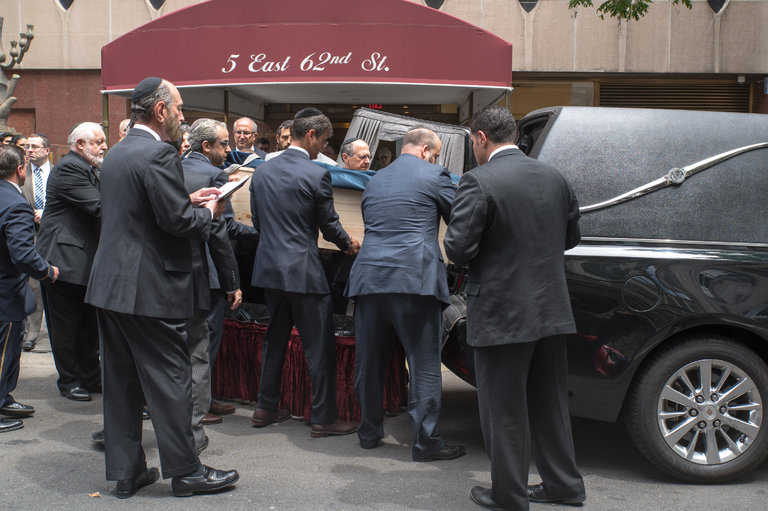
Outside the Orthodox 5th Avenue Synagogue on July 3, 2016, Wiesel’s coffin is placed into the back of the hearse. Wiesel died in New York on July 2nd at age 87. KENA BETANCUR/AFP/Getty Images
Elie Wiesel is already in the ground. Seems so fast, but is in keeping with the Jewish tradition of burying a person with expediency, according to the New York Times.
A hearse was seen outside the Orthodox Jewish synagogue and mourners were arriving around 10 a.m. Among them was former national director of the Anti-Defamation League Abraham Foxman, as reported by CBS.
From the NYTimes –
The funeral was a gathering of his family and close friends, held on Sunday at a synagogue on the Upper East Side of Manhattan. Inside the Orthodox Fifth Avenue Synagogue, about 100 people attended the ceremony. In a wheelchair, his widow, Marion, listened as Mr. Wiesel was eulogized by his son Elisha, a partner at Goldman Sachs. A young grandson, Elijah, also spoke about his grandfather. In attendance was Sheila Johnson Robbins, a member of the board of the Elie Wiesel Foundation for Humanity.
Around noon, the coffin with Mr. Wiesel’s body was wheeled from the synagogue surrounded by a dozen mourners, a simple pine box that is customary in Jewish funerals, a blue velvet cloth draped over it. Later that day, he was interred at Sharon Gardens cemetery, in the Westchester County town of Valhalla. At the burial in Valhalla on Sunday afternoon, family members and friends shoveled dirt onto the coffin, as is Jewish tradition.
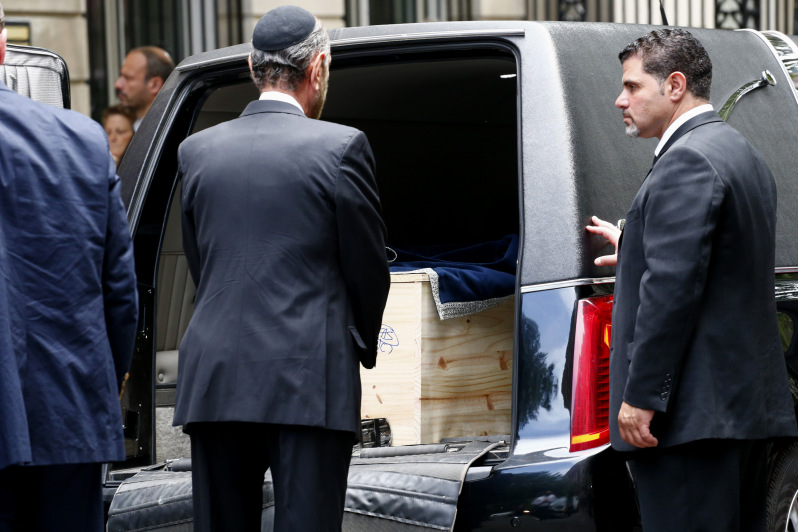
Here you can see the unadorned pine wood box with blue velvet covering that holds Wiesel’s remains as it is placed into a waiting hearse outside the Fifth Avenue Synagogue on July 3, 2016 in New York. KENA BETANCUR/AFP/Getty Images)
From the New York Daily News –
Inside the small sanctuary, Wiesel’s son struggled with his father’s death.
“I thought I was ready for this,” he said. “I thought I prepared myself. But I wasn’t ready. The newspapers were ready.”
Unlike his father, Shlomo Elisha Wiesel said he was not a man of faith.
“My father questioned God’s decisions,” he said. “I questioned his existence.”
“So can someone please help me? How is my father right now sending me his love while he’s no longer alive?” he asked as tears rolled down his face.
“Like Moses, my father did not want to die,” his son added. “He wanted to walk farther with all of us into the new century. But he took comfort in knowing a new generation would move forward his work.”
From People Magazine –
Also at the funeral, Wiesel’s son Elisha, a partner at Goldman Sachs, spoke about his father’s compassionate character to help others.
“My father raised his voice to presidents and prime ministers when he felt issues on the world stage demanded action. But those who knew him in private life had the pleasure of experiencing a gentle and devout man who was always interested in others, and whose quiet voice moved them to better themselves,” he said in a statement.
“I will hear that voice for the rest of my life, and hope and pray that I will continue to earn the unconditional love and trust he always showed me.”
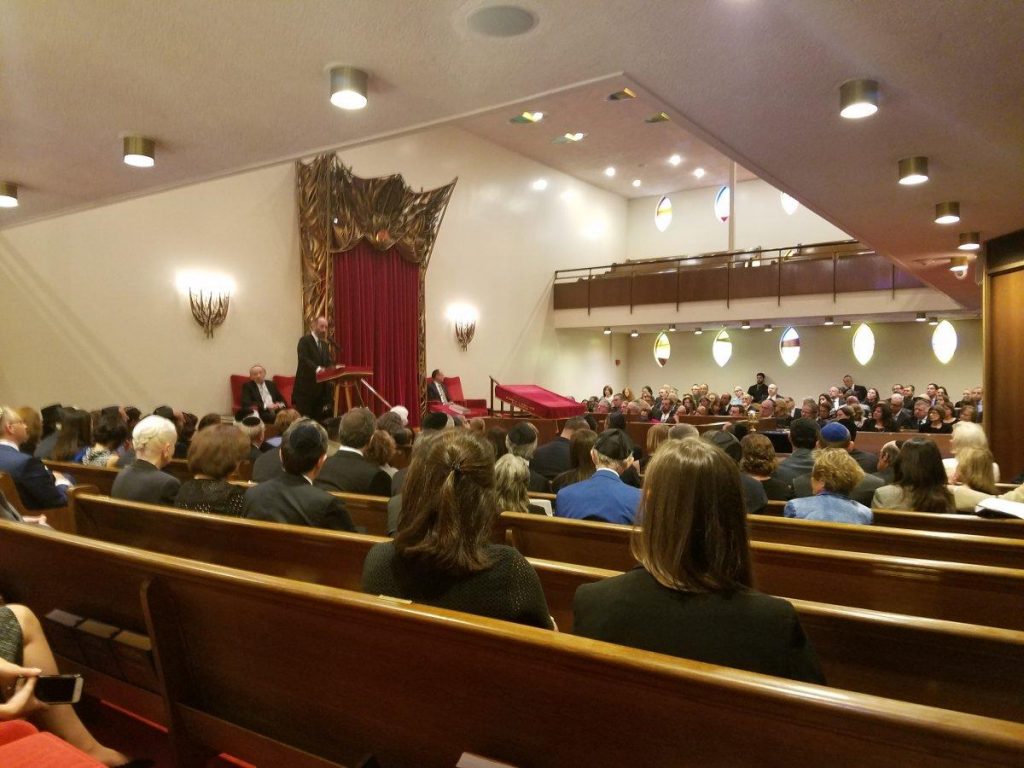
A private gathering of about 100 family members and friends come at short notice to mourn Elie Wiesel’s passing inside the Orthodox 5th Avenue Synagogue Sunday morning. [photo courtesy People magazine]
Strangely, during the funeral, a man walking in Central Park, which is close by the synagogue, stepped on a device on the ground that exploded and blew up his foot! You can read about it here. He is now said to be a tourist.
Saturday, July 2nd, 2016
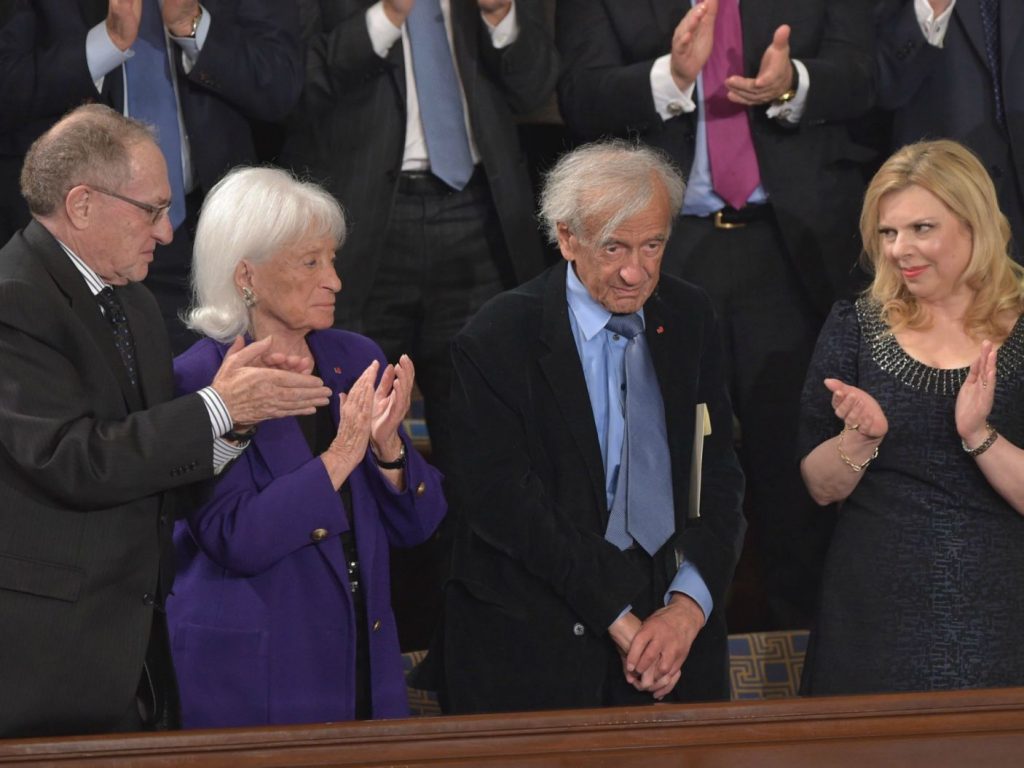
Elie Wiesel receives a standing ovation during Prime Minister Benjamin Netanyahu’s Congress speech, March 3, 2015. To the left, his wife Marion, far left, lawyer Alan Dershowitz. AFP photo
Haaretz announced that Elie Wiesel died today, Saturday, July 2 at the age of 87. Saturday is the Jewish Sabbath when Orthodox Jews are prohibited from any kind of work. The article did not give any indication of how, why, where but is a long history of his life and “achievements.”
His death was announced by a spokesman for Israel’s Holocaust memorial, Yad Vashem on Saturday. “Yad Vashem mourns the passing of Elie Wiesel-Holocaust survivor, Nobel laureate, renowned author,” the museum said on Twitter.
The New York Times writes that Wiesel “died at his home in Manhattan” and that “Menachem Rosensaft, a longtime friend and the founding chairman of the International Network of Children of Jewish Survivors, confirmed the death in a phone call.”
NBC News wrote:
Tributes for Wiesel immediately started pouring in Saturday, with Israeli Prime Minister Benjamin Netanyahu calling him a “beacon of light to the humanity of people who believed in the good of everyone.”
The World Jewish Congress President Ronald Lauder said in a statement that Wiesel “was more than a revered writer. He was also a teacher for many of us. He taught us about the horrors of Auschwitz. He taught us about Judaism, about Israel, and about not being silent in the face of injustice.”
Jerusalem Mayor Nir Barkat, who a few months ago gave Wiesel the medal of Honorary Citizen of Jerusalem, said of the author: “Instead of giving in to despair, the face of evil and cruelty that at the time was the darkest of humanity, he carried all the way through the message of tolerance and peace for all peoples of the world.”
And on and on it will continue.
My question is: Will he be buried in Israel? We will know fairly soon.















